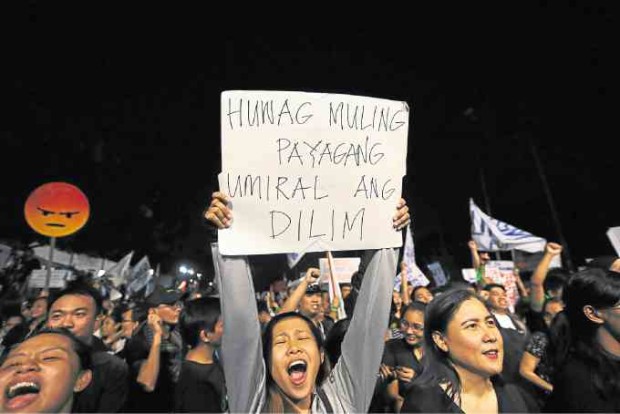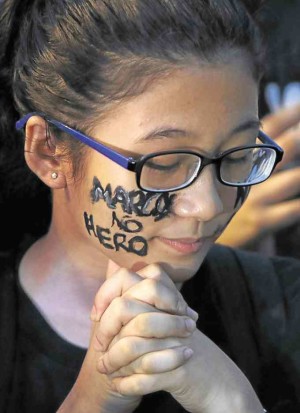The Antirevisionists are Inquirer’s Filipinos of the Year
Every year since 1991, the Philippine Daily Inquirer has sought to recognize the Filipino who made the most positive impact on the life of the nation.
Most years the title went to individuals (Haydee Yorac in 1992, Antonio Meloto in 2006); less often they went to collectives, either named (the Supreme Court justices in 2001) or nameless (postcalamity volunteers in 2009 and again in 2011).
This year, after 48 editors from the Inquirer and its affiliate platforms voted, the honor goes to a collective that is partly known and partly too many to be named: The Antirevisionists.
Of the 59 editors eligible to vote, 48 cast their ballot. Of the 48, a large plurality of 21 (44 percent) voted for the Antirevisionists.
The rest of the votes were distributed among the four other nominees: Vice President Leni Robredo (8 votes), Olympian Hidilyn Diaz (7.5), President Rodrigo Duterte (6) and Miss Universe 2015 Pia Wurtzbach (5.5).
Article continues after this advertisementA meeting of editors called after the vote confirmed the choice of the Antirevisionists and discussed the reasoning behind it in depth.
Article continues after this advertisementAware millennials
The first protest actions after the Marcos burial were spontaneous affairs, and led by young people scandalized by what the dictator’s heirs had done.
On Nov. 18, a mere 10 days after the Supreme Court’s majority decision allowed the Duterte administration to proceed with the burial, the Marcoses mounted an elaborate secret operation: The dictator’s remains were transferred by helicopter, a news blackout was imposed, and Libingan itself was locked down. After the burial, the Marcoses released photos and a same-day-edit video.
Within an hour or so of the burial, the protests started.
It began with one lone woman, her fist raised, standing outside the Libingan gates.
Nicole Aliasas, 22, was at work when she heard the news. She took an Uber to the cemetery and got there before noon.
“I was mad, really mad,” she told Scout magazine. “I’ve never felt that much need to do something until today. I was so near to Libingan that I knew I would never forgive myself if I didn’t do anything.
“I was scared hearing that there were no protesters yet. I knew I was going in alone, but the conviction in my heart was too strong to ignore.
“I thought about what this speaks about us Filipinos. All the atrocities during martial law are in history books. I’ve seen the documentaries.
“Thirty years after overthrowing the dictator, here we are laying him to rest on sacred ground intended for honorable men who truly served the country.
“I’m ashamed, really, that this is happening. But the fight is not done. That’s why I went there. To fight and to show that I am not allowing this. I am not okay with this.”
It quickly became clear that many others from Nicole’s generation were “not okay with this.”
Social media, that new frontier first colonized by the young, exploded with posts and memes expressing outrage. Student protesters with makeshift placards took to the streets in the afternoon, urging motorists to honk their horns to protest the burial. Many did.
That first night, the People Power Monument on Edsa, part of the hallowed stretch of the national highway that hosted millions of Filipinos demanding the dictator’s ouster in 1986, became the convergence point of public outrage.
The Inquirer reported: “The protesters at the People Power monument streamed in from the Katipunan schools—University of the Philippines Diliman, Ateneo and Miriam College—and from Ayala Avenue, where young professionals filled up every available space past 9 p.m.”
But it wasn’t just Metro Manila. Similar protest actions, also spontaneous, also driven by the anger and sense of aggrieved honor of the young, shook other cities, including Cebu, Bacolod and Cagayan de Oro.
The protest actions on Nov. 25 were even bigger. Despite the rains, as many as 20,000 protesters trooped to Luneta. Again, most of them were too young to have been around during the martial law years.
And there were more rallies: in Tuguegarao, Baguio, Cabanatuan, Angeles, Los Baños, Legazpi; in Tacloban, Cebu, Bacolod, Iloilo, Roxas, Kalibo; in Cagayan de Oro, Zamboanga, Davao.
The rally at the People Power Monument on Nov. 30 was the biggest. As many as 50,000 converged on the site.
Other cities also marked Bonifacio Day by protesting the dictator’s burial in the heroes’ cemetery, including Cebu, Bacolod and Cagayan de Oro.
In these protest actions, politically aware millennials (with their clever, viral placards) took the lead.
“They were the first to raise a fist at this administration for trifling with the memory of human rights victims and democracy itself,” an editor explained during the nomination process.
Their activism is a source of hope and renewal. It means that Filipinos have not entirely become resigned to a Marcos ascendancy; that, even if the very symbol of martial law has stealthily been interred in state-decreed hallowed ground, the young (or at least some of them) have seen fit to take up the flag of defiance, and wave it.

DEFIANT Millennials took the lead in protest rallies using social media and other means to express outrage.
Dignified victims
The rallies gave pride of place to the victims of martial law. While student leaders spoke and entertainers sang, the most important testimony was heard from those who had directly suffered during the Marcos years.
Sometimes their mere presence was enough. At the Nov. 18 protest at the People Power Monument, millennials milled about in the company of human rights victims like Fe Mangahas, Aida Santos Maranan, Sonny Melencio and Boni Ilagan.
At the Nov. 25 rally at Rizal Park, a special tribute was paid to martial-law-era activists, including Rene Saguisag, Satur Ocampo and Neri Colmenares, and to student leaders of that time, including Medi de Jesus.
In truth, the human rights victims have never stopped protesting the enormity of the martial law experience. Indeed, the first petitions appealing to the Supreme Court to prevent the Marcos burial were filed by victims themselves, including Ocampo, Edcel Lagman, Etta Rosales and Heherson Alvarez.
The aging but still defiant victims of martial rule “continue to symbolize the righteous cry for justice of the oppressed during the Marcos regime,” an editor said during the nomination stage.
“Their lives serve as a powerful reminder of the importance of public vigilance and religious adherence to democratic checks and balances in foiling any abuse of power between the coequal branches of government.
“Their documented struggle has become a testament to the enduring power of the freedoms we enjoy today—of speech, press and assembly—to correcting injustices and bringing back decency and honesty in public office.”
Their presence at the rallies and their participation in the planning of the protests lent both dignity and continuity to the resistance.
Powerful dissents
During the nomination process, an editor called attention to “the five Supreme Court justices who went beyond a cold reading of the law” and voted against the Marcos burial.
The five who dissented from the egregious majority decision were Chief Justice Maria Lourdes Sereno, Senior Associate Justice Antonio Carpio and Associate Justices Marvic Leonen, Francis Jardeleza and Alfredo Benjamin Caguioa. Among them, they wrote four powerful dissenting opinions.
Sereno took the majority to task for following a course of action that would result in the narrowing of the scope of the judiciary’s own powers:
“If the Court unduly shies away from addressing the principal question of whether a decision to bury the former President would contradict the anti-Martial Law and human rights underpinnings and direction of the 1987 Constitution, it would, wittingly or unwittingly, weaken itself by diminishing its role as the protector of the constitutional liberties of our people.”
This self-emasculation in favor of an assertive presidency did not only recall the judiciary’s subservience to Marcos, the lowest point in its history; it also represented a rejection of the additional powers the Constitution granted the Court precisely to prevent another Marcos.
Carpio used the same constructive interpretation the Court had used in other difficult cases to decide the essential issue.
Bearing down on Marcos’ alleged qualification to be buried in Libingan, he argued that the regulation “which respondents rely on to justify the interment of Marcos … specifically provides that ‘personnel who were dishonorably separated/reverted/discharged from the service’ are not qualified to be interred at Libingan. Marcos, who was forcibly ousted from the Presidency by the sovereign act of the Filipino people, falls under this disqualification.”
Leonen, who raised the myth-versus-history warning, reminded petitioner and respondent alike of the nature of our political system:
“Under our constitutional order, Presidents, unlike kings, earn their honors. As Presidents are public servants, their position in itself should not be the basis to glorify them. Neither should their place in history be determined by a succeeding President. Only the sovereign Filipino people deserve to determine a President’s place in history.”
The most comprehensive dissent, that of Caguioa, rebutted each of the arguments raised by the majority decision. It offered a moving meditation on the true stakes of the case, and concluded on this note:
“Above all, this [dissenting opinion] is a tribute to the fallen, desaparecidos, tortured, abused, incarcerated and victimized so that the dictator could perpetuate his martial rule, and to those who fought to attain the freedom which led to the very Constitution from which this Court derives the power to make the decision that it reached today—that their sacrifices, sufferings and struggles in the name of democracy would be duly acknowledged and immortalized.”
In that same spirit, moved by the same impulse, the Inquirer wishes to acknowledge and remember for all time the millennial protesters, the many victims of martial rule and the courageous dissenters, as well as others like them who dare resist the attempt to revise history itself, as 2016’s Filipinos of the Year.


